Sourdough Sandwich Bread
This post may contain affiliate links.
One of the recipes I get asked for the most is a soft sourdough sandwich bread made in a loaf pan. After trialling many inclusions and getting my family to vote on the best one, this easy recipe has become our family's go to soft sourdough sandwich loaf. Easy to bake and freeze, as well as the perfect toasting loaf, I'm sure you and your family will love it too!

Why You'll Love This Recipe!
Soft, Closed Crumb - A good sourdough sandwich bread needs to have a closed crumb (so the fillings don't fall out) and a light airy texture. I personally like a softer crust on my sandwich bread, but you can certainly make this sandwich loaf with a crustier crust.
It's So Forgiving - Unlike other sourdough bread where you have to be a little more gentle to preserve the bubbles and shape, this sourdough sandwich loaf is totally forgiving and needs no special treatment!
Makes Perfect Sandwiches - Always soft, never crumbly, this soft sourdough sandwich loaf makes the perfect sourdough sandwiches!

Ingredients
- Bread Flour - I prefer to make my sandwich loaves with protein rich bread flour rather than all purpose flour. If you're looking for a whole wheat flour alternative, I recommend this whole wheat sourdough sandwich bread.
- Sourdough Starter - You'll need active sourdough starter. I generally use 100g of starter in this loaf and don't have any issues bulk fermenting overnight, so long as the temperature isn't above 21ºC (69.8ºF). If you want to leave your sandwich loaf to bulk ferment overnight (and it's a bit warmer where you live), I recommend using just 50g of starter. You don't have to adjust anything else in the recipe. You can read about the effect of the starter amount on your sourdough.
- Water
- Butter & Sugar - To give this sourdough sandwich bread it's light, airy crumb I've added some butter and sugar. The butter and sugar help to give the bread a softer crust, perfect for a sandwich loaf. You can use the same weight in olive oil or coconut oil as butter if you want to make the loaf dairy free. You can use maple syrup instead of sugar, or leave it out altogether if you wish, but this will change the flavor and texture of the loaf.
- Salt
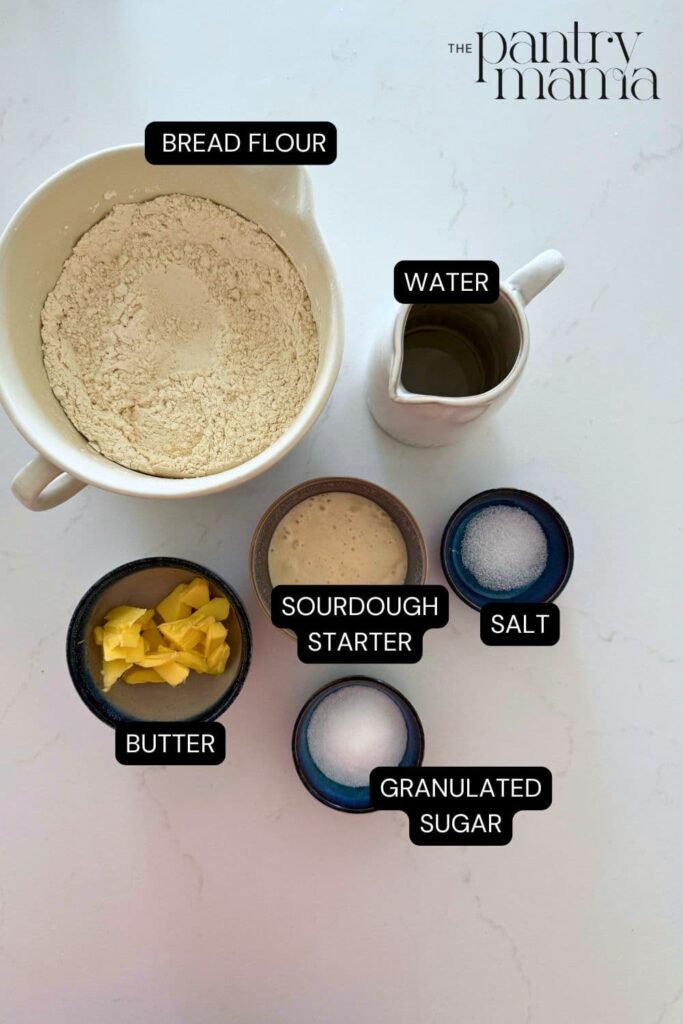
Equipment
Bread Pans - you'll need a selection of sandwich loaf pans to bake your bread. Having 2 or even 4 is a great idea if you want to bake several loaves at once. I love using USA pans and almost always bake this loaf in a USA Pan Pullman Pan (I do not use the lid) measuring 4"D x 4"W x 9"H or USA Pan 1.5 Pound Loaf Pan measuring 5"D x 10"W x 3"H.
Plastic Bread Bags - these are a great way to store your bread and fantastic if you're making multiple loaves at once. I do freeze my bread in these if I'm not freezing it for long, but if you are going to freeze your sourdough sandwich loaves for a few months, I recommend using freezer safe Ziplock bags.
Bread Slicing Guide - these are super handy if you're wanting perfectly sliced sandwich bread, although just having a great bread knife can be just as important to get even slices.

Overview: How To Make Sourdough Sandwich Bread
This sourdough sandwich bread recipe is written for a stand mixer (or Thermomix), which makes the process so much easier and saves time—something I appreciate with three kids in the house! There’s no stretching and folding involved, just straightforward kneading, which is perfect if you’re short on time. That said, you can absolutely knead this dough by hand. It does take a bit more effort to work in the butter and sugar, but it’s completely doable. However you knead it, the dough should be silky and elastic by the end, with no stickiness since this is an enriched dough.
Sourdough sandwich bread is a little different from a traditional sourdough loaf. The crumb is tighter, the crust thinner, and it doesn’t require a cold ferment. Instead, it goes through a bulk ferment followed by a second rise after shaping, where the dough fills the loaf pan at room temperature. You can delay baking by placing the dough in the fridge once it has filled the pan, though I wouldn’t leave it more than 24 hours. For the best results, it’s usually better to bake it right away.
Shaping a sourdough sandwich loaf is wonderfully simple. Once your dough has finished its bulk ferment, tip it onto the counter with the smooth side down and the sticky side up. Ease it into a rough rectangle with the short edge facing you, then gently pop any large bubbles and press it out lightly with your fingertips. Roll the dough into a log, tucking the ends under neatly, and let it rest on your work surface for about 30 minutes. After resting, tighten the log slightly by pulling it against the counter to create surface tension, then place it seam side down into a buttered loaf pan. Unlike shaping a boule or batard, you don’t need to overthink this step. If the top isn’t perfectly tight, don’t worry—the loaf will still rise beautifully above the rim of the pan and taste absolutely delicious when it comes out of the oven.
You'll find step by step instructions in the recipe card at the end of this post, as well as a video.
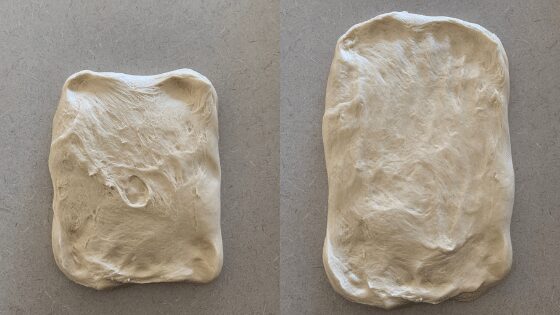

Baking Timeline
You can easily make this sourdough bread fit your schedule, it just needs a little tweaking. But since we are all about easy sourdough on any schedule here at The Pantry Mama, I've got your back! Here's the schedule I follow when making this sourdough sandwich loaf. A few things to note when thinking about tweaking this schedule:
- Bulk Fermentation - this is a low hydration loaf, as well as an enriched loaf, hence bulk fermentation and proofing will be fairly slow.
- Proofing - this loaf involves allowing the dough a second rise and you'll want to ensure the dough rises about the lip of the pan.
| TIME | PROCESS |
|---|---|
| 8:00 AM | Premix the dough and allow it to rest. |
| 8.30 AM | Add the salt, butter and sugar. |
| 9.30 AM | Knead the dough, resting when you need to. |
| 10.00 AM | Cover the dough, allowing it to bulk ferment. |
| 4.00 PM | Time to shape your sourdough sandwich loaf and place into your loaf pan. |
| 4.30 PM | Cover the pan and leave your loaf for the second rise. You want the dough to rise above the lip of the pan. |
| 9.00 PM | Bake your sourdough sandwich loaf. |
| 9.40 PM | Leave the loaf to cool on the counter overnight, ready for toast and sandwiches in the morning. |
Flavor Variations
While this recipe will never do you wrong, you can always add a few variations to make it a little more exciting! Try some of these:
- Hawaiian Loaf – Replace the water with pineapple juice for a delicious variation. It tastes quite similar to these sourdough Hawaiian rolls.
- Honey & Oat Sandwich Loaf – Add 20g of honey and 50g of oats to the mixture when you add the butter, sugar and salt. If you’d like to add oats to the top you should do so when you put the dough into the tin – spray the loaf lightly with water so the oats stick to the top.
- Multigrain Sandwich Loaf – Add 50 to 100g of your favorite seeds to the mixture when you add the butter, sugar and salt. Seeds like sesame, sunflower, pumpkin and flax work really well.
How to Store + Freeze
I make a lot of this sourdough sandwich bread! So here's how we store and freeze it in my home:
Store at Room Temperature - I use large ziplock bags or these plastic bread bags to store sliced loaves at room temperature. It lasts around 48 hours at room temperature once sliced. After that, it's suitable for toast.
Freezer - I store unsliced loaves in large ziplock bags for convenience. I tend to slice them once thawed.
Sandwiches - If you're a mama and you're making school lunches, this bread works so well! I even make a big batch of sandwiches and freeze them, making school mornings so much easier!
Things like ham and cheese, plain ham, peanut butter and jelly, honey or jam work the best when freezing. They defrost easily and you wouldn't even know they were frozen! To store frozen sandwiches, you can place each sandwich in a plastic ziplock bag. This makes them easy to place in lunchboxes in the morning.
Frequently Asked Questions
This dough is very slow to rise, so your dough may be rising, just a little more slowly than you're used to. It's not uncommon for this dough to take 12 hours for bulk fermentation. Make sure you keep the dough warm. One of the most common reasons for sourdough bread dough not to rise is that your sourdough starter is not active enough or not mature enough.
Gumminess is generally a sign that your sandwich loaf is under fermented. You'll generally see a line of under cooked dough at the base of the loaf to go along with the gummy crumb.
You can add inclusions to this recipe if you want to. I find the best time to add them is during the kneading of the dough.
This dough is very quick to knead with a stand mixer, but will take around 8-10 minutes to knead by hand.
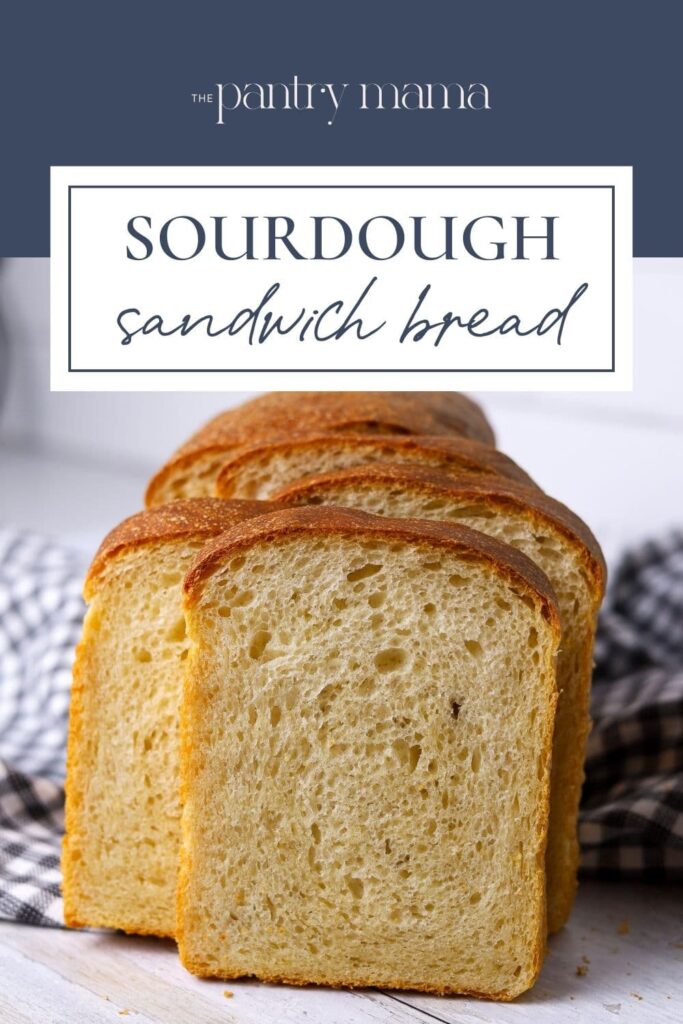
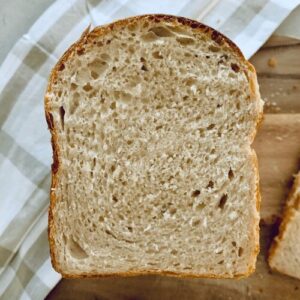
Sourdough Sandwich Bread Recipe
Video
Equipment
- Stand Mixer
- Loaf Pan (USA Pullman Pan 9" x 4" x 4" with no lid)
Ingredients
- 500 g Bread Flour
- 100 g Sourdough Starter (active, fed and bubbly)
- 280 g Water
- 60 g Butter (soft, cubed)
- 10 g Salt
- 20 g Granulated Sugar
Instructions
- Premix & Autolyse:Add your sourdough starter, flour and water into the bowl of your stand mixer.Knead the ingredients for around 30 seconds (using your dough hook) until they are just combined into a shaggy dough. Leave to autolyse for around 30 minutes.
- Now add the rest of your ingredients - salt, butter and sugar.Knead the ingredients for around 1 minute or until they are combined together. Now leave to rest for around 30 minutes.
- Kneading Your Sandwich Dough:Using the dough hook, knead the dough for around 3 minutes. The dough should become very elastic. You won't be able to see the butter as it will be well combined into the dough. Now give your dough a 30 minute rest.
- Now, knead your dough in the mixer for another 2-3 minutes. You'll know it's ready when it is slapping the sides of the bowl, it's soft and pliable and you can touch it without it sticking to your hands.If it's not quite there, it's ok to knead for a few more minutes to develop the gluten and get it to where it needs to be.
- Bulk Ferment:Once your dough is kneaded sufficiently, you need to bulk ferment it. At this point, you can just leave the dough as it is, covering it with some plastic wrap to stop it drying out. If you prefer your dough to be a bit neater, you can wet your hands and fold it into a neat ball.As with any sourdough bread, the bulk ferment time will depend on the temperature in your kitchen and of course the strength of your starter. You're looking for your dough to be just UNDER double.
- Shaping:Once your dough has finished its bulk ferment you can shape your dough. Before you start shaping, lightly butter your loaf pan.Ease your dough out of the bowl using a silicone dough scraper, remembering to have the smooth side on the counter and the sticky side facing up. You shouldn't need any flour for this as your dough shouldn't stick (it's such a beautiful silky, enriched dough).Gently ease your dough out into a rough rectangle, with the shortest side in front of you.Pop any large bubbles and gently flatten the dough using your fingertips. Then roll the dough up into a log (using the short side) and tuck the ends under. Leave the dough to sit and relax for around 30 minutes. After 30 minutes, tighten up the log by pulling the dough a little, using the sticky underside to create tension. Then simply plop the log into your buttered pan.
- Second Rise:Once your bread has been shaped and is in the tin, you'll need to let it rise again so that it fills up the shape of the pan. This should only take a few hours, but like the bulk ferment, this will depend on the strength of your starter and the temperature of your kitchen. You'll know it's done when it's risen above the lip of the pan (if you're using an open pan). It will be rounded on the top. When you poke it it will leave a slight indent but spring back nice and slowly. If you shaped it quite tight, you'll see some tension on the top of the dough as it's risen.
- Baking Your Sandwich Bread:Preheat your oven to around 180C/350F. Bake your sourdough sandwich loaf for approximately 40 minutes or until the top is golden brown. It may take a little longer depending on your oven. Once the loaf is baked, carefully place it on a rack to cool. Try to leave it at least one hour before you slice into it.
Notes
Nutrition




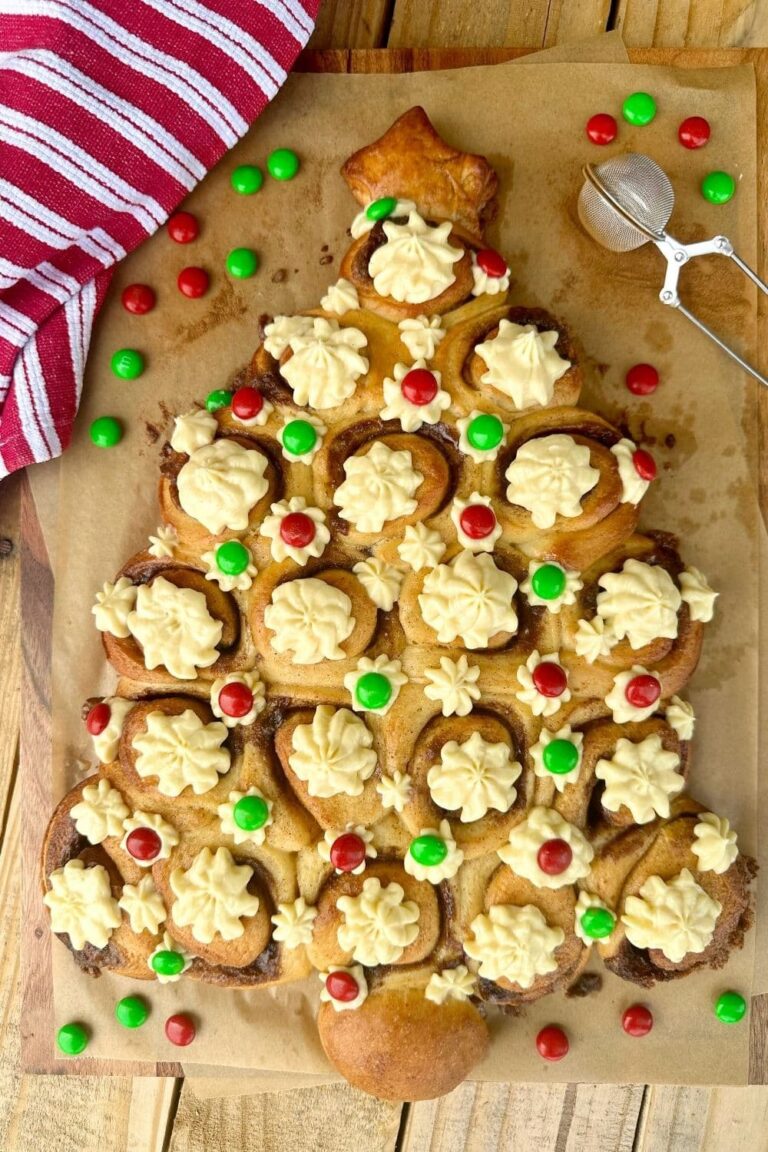
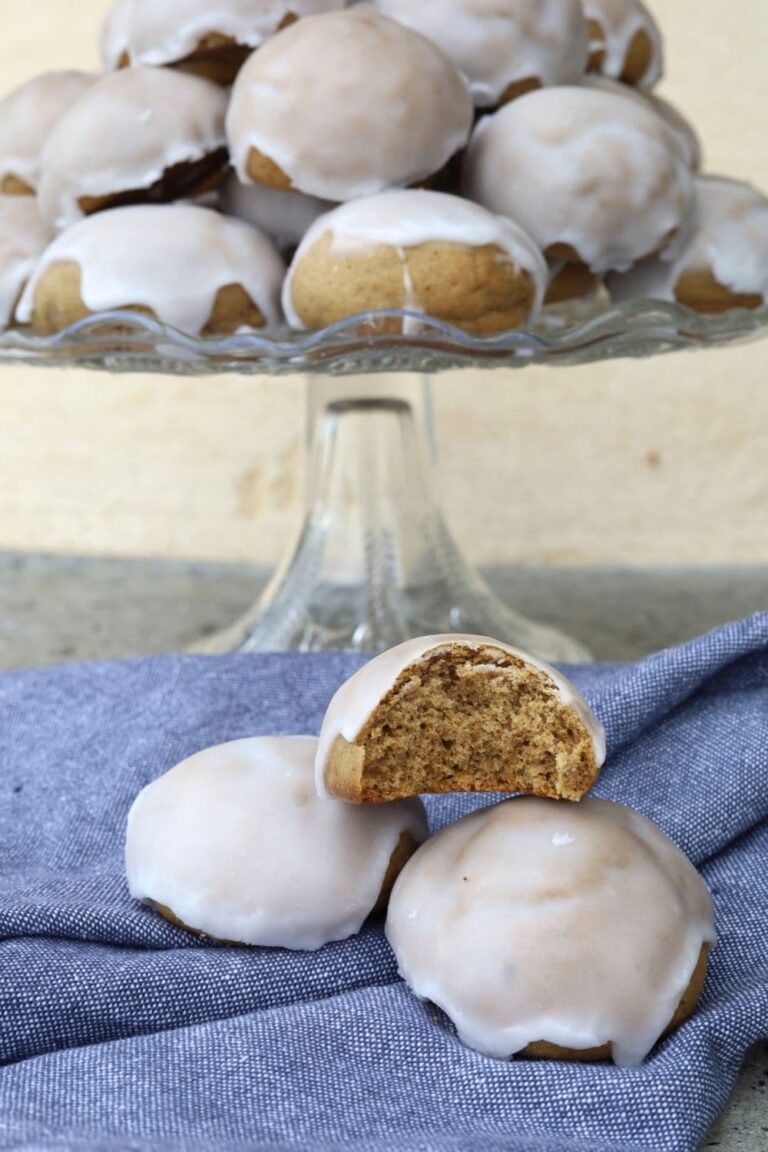

conversion to US please
I only write recipes in grams as this is a universal measure - cups are not accurate, particularly for baking 🙂 You can read more about the reason it's better to weigh here: https://www.pantrymama.com/benefits-of-weighing-sourdough-ingredients
After bulk ferment and after shaping it and then letting it rest on the counter for 30 min, do you take the shaped log and just pull on it on the counter to create further surface tension before placing it into tin OR do you press it all out again and reshape into a log again and then place into tin? I’m thinking the former is what I’m supposed to, correct?
May I please ask what ratio you feed your starter for this particular recipe? What do you find makes the best rise? I do a lot of 1:1:1 but my bread has been so sour lately. Thank you and God Bless.
Can you make this recipe using wheat flour or a mix of wheat and bread flour?
I did! I used 100 gm whole wheat and increased hydration by 10 gm as well.
Do you cover your bread when it’s resting after shaping and when it’s in the bread tin for the second rise?
I resisted metric measurements for many years, but, with sourdough, I became a convert. Measuring in grams is SO much easier than US customary, and more accurate, too. Instead of asking Google to convert every gram to cups and Tbs, I simply pull out my new, $10 scale, and I'm good to go. (I still have no idea what "7 grams" is in "my measurements" but, it works so well.) This recipe is excellent.
Lovely recipe!
How long did the bulk fermentation take for you and what temperature was your room at?
Hello, how do you time this- do you do all the steps in one day? Im wondering how I could space this out over a couple of days to fit around work/baby. Could I pop the loaf into the fridge overnight at any point so I can finish the bake on the second day?
Thank you x
Can this easily be made into a cinnamon raisin loaf?
You can search on Google, try typing: Grams in Oz, this is how I do it when I see US recipes for Brazilian measurements, which are in grams.
I don't use butter. I use one egg.
Regards
Terry
Is there a conversion for hand mixing for those of us without a stand mixer?
So glad to find a recipe in grams. Thank you.
So is it possible to put the tin in the fridge for a cold retard?
Also, have you subbed a little whole wheat, maybe 25%? Any adjustments?
Hi Kate,
Can you guide me on Amazon to the 8x4x4 pan you mention above? The link you provide, points to a 4.8" x 12.8"x 4.7" pan.
Thanks!
Can I replace some of the bread flour with whole wheat...say 25% whole wheat and 75% bread flour? Would I need to make any changes to the amount of water?
Is the butter room temp or cold or melted?
I’ve made this 3 times already. Kids love them! My only problem is that the dough is always lumpy. No matter what I do there are always pieces of hard flour in the bread. What am I doing wrong? I’m following the directions as written.
Can the second ferment be done in the fridge to further develop the flavour and retard the rise overnight? Thanks 😊
Is this recipe adaptable for the longer Pullman loaf pan? I believe it is 8.4 inches in length. Thanks!! Can't wait to try it.
Sorry!! I meant 13 inches long.
My breads seem under baked. Should the temp be 450F?
I have made both this recipe and the sourdough discard sandwich bread. The discard loaf crumb comes out much softer and fluffy, while this loaf comes out with a much tighter, denser crumb. Is that to be expected or am I doing something wrong?
Anthony
The pan you use is for a 450g recipe. I would like buy that tin and use the lid but I think this recipe would be to big
This sounds amazing! Wondering if the 2nd rise could be done in the fridge to promote a more sour flavour? We like a super sour sourdough, but want it for sandwiches as well!
Also - what are your thoughts on stoneware bread pans? Or are metal ones better for sourdough? Thanks so much!
I have a 13 inch Pullman loaf pan, that I prefer to bake with the lid off. How would you suggest I modify this recipe to fit that size pan?
How would you convert this recipe to fit in an 13”x4”x4” Pullman pan?
How long does the second rise take, generally? Like an hour or two? Not sure how long to expect roughly. Thanks!!
Can you knead this by hand?
I’ve followed through all the rests and final knead and it is still exceptionally sticky. Is this correct?
Bread came out great! Any tips on how to store it?
Here's some good storage ideas 🙂 https://www.pantrymama.com/how-to-store-sourdough-bread/
I'm trying this recipe today! I am just curious about the difference in this bread vs a traditional sourdough loaf concerning the amount of gluten left in it. I've learned from your site that the longer the ferment the more broken down the gluten bonds become... so is this still a beneficial way to get all the goodness provided from a regular sourdough? I hope this makes sense! 🙂
When the recipe calls for powder milk, if you do not use it, do you just leave it out.
And can you use whole milk in the water instead
After the 1st rise can I put this in the fridge and bake in the morning?
I am not an expert bread baker and don't have the things needed to make a beautifully artisan-looking sourdough loaf. So I was looking for a recipe that I could make in sandwich loaf style. As it turns out, my bread did look beautiful anyway! I added some everything bagel seasoning, which tasted and look great, plus it was the best rise I have ever had in a loaf 🙂 What a great recipe! I am definitely printing it to add to our collection.
I put it in a tin then in the fridge. Do I need to let it warm up and rise to the top of the tin before baking? Should I have let it have a second rise before putting in the fridge?
I have made this recipe twice and both times, it turned out very tasty, but it’s sort of dense. From what I have read, it was over-proofed. I have to start late in the evening so that I can leave it to bulk ferment overnight. I know that there are several factors that determine the length of the bulk fermentation, but, in a kitchen where the temperature is likely to be between 68 to 74 degrees, what would be the approximate number of hours for bulk fermentation?
I am really enjoying the recipe and my husband likes the taste but not the density.
Oh this looks so great! As do all your recipes. I am still pretty new to sourdough baking. Now I will also be learning to use fresh milled (sprouted hard white wheat) flour in various applications. Yum
Do you think there's any chance of making a good sourdough sandwich loaf with that flour? I realize the flour will be pretty different, but I don't know if I can adapt things to make it usable in this type of recipe. Is it crazy to hope?
I would totally appreciate any insight I can glean to help avoid bread disaster 😉
What size pullman tin is best for this recipe
A good recipe because I was using thermomix and also not reading the recipe properly like didn't autolyse, so put everything in and knead and then left it aside for 1 hour instead. Use 2 loaf pan as I am used to putting only 500g of bread mixture per loaf pan. Reduced salt to 10g and sugar to 20g. Still turned out soft! I baked them for 20 mins in combi oven as I made it into 2 loafs and consider them ready when they were hollow to the knocks. Despite all that, came out soft and nice texture! A bit tangy may be due to my lesser sugar etc but great for a first try. Thanks!
No need to butter your toast. On my second try, I went down to 40 g butter from the original 60 and was quite happy. Great hearty but soft, loaf bread.